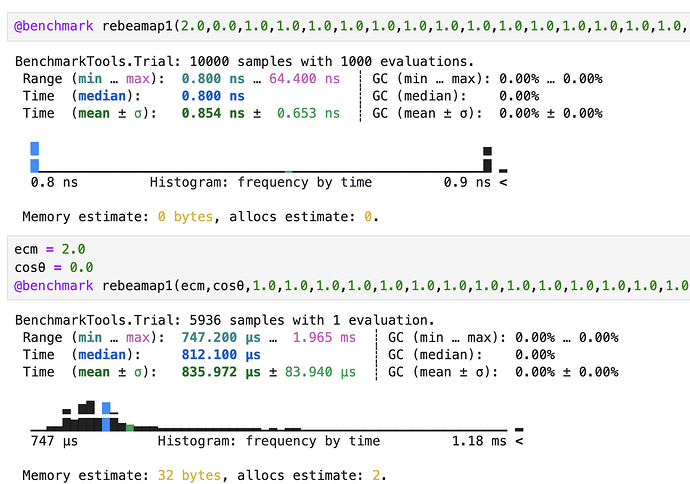先以一个简单的多项式函数为例来描述我的疑惑
定义一个普通的多项式函数,直接代值计算的速度很快(0.8ns):
f1(x,y)=x^3*y^3+2*x^2*y+3*x*y^2
@benchmark f1(1.0,2.0)
BenchmarkTools.Trial: 10000 samples with 1000 evaluations.
Range (min … max): 0.791 ns … 12.333 ns ┊ GC (min … max): 0.00% … 0.00%
Time (median): 0.875 ns ┊ GC (median): 0.00%
Time (mean ± σ): 0.874 ns ± 0.128 ns ┊ GC (mean ± σ): 0.00% ± 0.00%
█
▂▁▁▁▁▁▁▁▁▁▁▁▁▁▁▁▁▁▁▄▁▁▁▁▁▁▁▁▁▁▁▁▁▁▁▁▁▁█▁▁▁▁▁▁▁▁▁▁▁▁▁▁▁▁▁▁▂ ▂
0.791 ns Histogram: frequency by time 0.917 ns <
Memory estimate: 0 bytes, allocs estimate: 0.
但是以参数传递的形式代入,或者提取数组元素代入,均会慢不少(17ns和51ns):
a = 1.0
b = 2.0
@benchmark f1(a,b)
BenchmarkTools.Trial: 10000 samples with 998 evaluations.
Range (min … max): 16.366 ns … 36.281 ns ┊ GC (min … max): 0.00% … 0.00%
Time (median): 17.577 ns ┊ GC (median): 0.00%
Time (mean ± σ): 17.706 ns ± 1.295 ns ┊ GC (mean ± σ): 0.00% ± 0.00%
▃▃▁▃▄▂▅██▅▃ ▂
▇████████████▇▇▅▅▅▆▆▅▆▄▄▄▄▄▆▅▆██▇▇▄▆▅▄▅▄▃▃▃▁▅▄▄▄▁▃▁▁▃▁▃▁▄▄▃ █
16.4 ns Histogram: log(frequency) by time 24.4 ns <
Memory estimate: 16 bytes, allocs estimate: 1.
c=[1.0,2.0]
@benchmark f1(c[1],c[2])
BenchmarkTools.Trial: 10000 samples with 990 evaluations.
Range (min … max): 45.833 ns … 202.441 ns ┊ GC (min … max): 0.00% … 0.00%
Time (median): 49.706 ns ┊ GC (median): 0.00%
Time (mean ± σ): 51.062 ns ± 5.727 ns ┊ GC (mean ± σ): 0.00% ± 0.00%
▁█ ▃▂
▄▂▁▁▁▁▁▂▃██▆██▄▃▃▂▃▃▃▃▂▂▂▁▁▁▁▂▂▂▃▂▂▁▁▁▁▁▁▁▂▂▂▁▁▁▁▁▁▁▁▁▁▁▁▁▁▁ ▂
45.8 ns Histogram: frequency by time 64.1 ns <
Memory estimate: 48 bytes, allocs estimate: 3.
所以当我想提取一个数组中的数据代入此函数处理,以得到一个新的函数时,新函数的运算速度就会很慢:
arr=[1.0,1.0,1.0,1.0,1.0]
function f2(y)
res=0.0
for i=1:5
res+=f1(arr[i],y)
end
return res
end
@benchmark f2(2.0)
BenchmarkTools.Trial: 10000 samples with 362 evaluations.
Range (min … max): 248.848 ns … 126.508 μs ┊ GC (min … max): 0.00% … 99.75%
Time (median): 266.804 ns ┊ GC (median): 0.00%
Time (mean ± σ): 286.499 ns ± 1.264 μs ┊ GC (mean ± σ): 4.88% ± 2.70%
█
▃▄▂▂▂█▅▁▁▃▅█▇▃▃▃▃▃▂▂▂▂▂▂▂▂▂▂▂▃▂▂▂▂▂▂▁▁▁▁▁▁▁▁▁▁▁▁▁▁▁▁▁▁▁▁▁▁▁▁▁ ▂
249 ns Histogram: frequency by time 341 ns <
Memory estimate: 320 bytes, allocs estimate: 20.
可看到循环5次得到新函数的f2,其计算速度为280ns,约为每次代入数组元素值到f1计算时间(51ns)的5倍。
对于上面这个简单函数,几种代参方式速度上的差异可能还不是很大,但当我的函数是一个非常复杂的多项式函数(下图的rebeamap1)时,直接计算 和 传递参数/提取数组元素为参 计算速度的差异十分巨大(从1ns到约700μs):
所以当我用其去做例子中的循环提取数组数据,以定义出一个新函数时,速度很不理想。
我的第一个疑问是这种速度差异的主要来源是哪,我猜测可能是函数直接代入常量时会触发编译优化,但是不清楚具体原理以及速度差异为何这么大;
第二个疑问是既然直接代数计算函数的速度很快,是否有优化方法使上面定义f2的例子中,循环中每次提取数组元素的计算,都转换成类似的直接代数计算。还是说这是个原则上没办法实现的事情。
期待大家的解答,万分感谢了!
